RBSE Class 11 Biology Important Questions Chapter 5 Morphology of Flowering Plants
Rajasthan Board RBSE Class 11 Biology Important Questions Chapter 5 Morphology of Flowering Plants Important Questions and Answers.
RBSE Class 11 Biology Chapter 5 Important Questions Morphology of Flowering Plants
Multiple Choice Questions
Question 1.
Plants which produce characteristic pneumatophores and show vivipary belong to:
(a) Mesophytes
(b) Halophytes
(c) Psamnophytes
(d) Hydrophytes
Answer:
(b) Halophytes

Question 2.
In Bougainvillea thorns are the modification of:
(a) stipules
(b) adventitious roots
(c) stem
(d) leaf
Answer:
(c) stem
Question 3.
The morphological nature of edible part of coconut is:
(a) perisperm
(b) cotyledon
(c) endosperm
(d) pericarp
Answer:
(c) endosperm
Question 4.
The standard petal of a papilionaceous corolla is also called:
(a) pappus
(b) vexillum
(c) corolla
(d) carina
Answer:
(b) vexillum
Question 5.
Stems modified into flat green organs performing the functions of leaves are known as:
(a) phyllodes
(b) phylloclades
(c) scales
(d) cladodes
Answer:
(b) phylloclades
Question 6.
Which of the following is not a stem modification:
(a) Thorns of citrus
(b) Tendrils of cucumber
(c) Flattened structures of opuntia
(d) Pitcher of Nepenthes
Answer:
(d) Pitcher of Nepenthes
Question 7.
Tricarpellary, syncarpous gynoecium is found in flowers of:
(a) solonaceae
(b) fabaceae
(c) poaceae
(d) liliaceae
Answer:
(d) liliaceae
Question 8.
Free central placentation is found in:
(a) Dianthus
(b) Argemone
(c) Brassica
(d) Citrus
Answer:
(a) Dianthus

Question 9.
Radial symmetry is.found in the flowers of:
(a) Brassica
(b) Trifolium
(c) Pisum
(d) Cassia
Answer:
(a) Brassica
Question 10.
How many plants among Indigofera, Sesbania, Salvia, Allium, Aloe, mustard, groundnut, radish, gram and turnip have stamens with different length in their flowers?
(a) Three
(b) Four
(c) Five
(d) Six
Answer:
(b) Four
Question 11.
The term ‘polyadelphous’ is related to:
(a) gynoecium
(b) androecium
(c) corolla
(d) calyx
Answer:
(b) androecium
Question 12.
Flowers are unisexual in:
(a) Pea
(b) Cucumber
(c) China rose
(d) Onion
Answer:
(b) Cucumber
Question 13.
Roots play insignificant role in absorption of water in:
(a) sunflower
(b) Pistia
(c) Pea
(d) Wheat
Answer:
(b) Pistia
Question 14.
Axile placentation is present in:
(a) Dianthus
(b) Lemon
(c) Pea
(d) Argemone
Answer:
(b) Lemon
Question 15.
Among china rose, mustard, brinjal, potato, guava, cucumber, onion and tullip how many plants have superior ovary?
(a) Five
(b) Six
(c) Three
(d) Four
Answer:
(b) Six

Question 16.
Placenta and pericarp are both edible portions in:
(a) apple
(b) banana
(c) tomato
(d) potato
Answer:
(c) tomato
Quesiton 17.
When the margins of sepals and petals overlap one another without any particular direction, the condition is termed as:
(a) vexillary
(b) imbricate
(c) twisted
(d) valvate
Answer:
(b) imbricate
Question 18.
Which one of the following statements is correct?
(a) The seed in grasses is not endospermic
(b) Mango is a parthenocarpic fruit
(c) A proteinaceous aleurone layer is present in maize grain
(d) A sterile pistil is called staminode
Answer:
(c) A proteinaceous aleurone layer is present in maize grain
Question 19.
An example of edible underground stem is:
(a) carrot
(b) groundnut
(c) sweet potato
(d) potato
Answer:
(d) potato
Question 20.
An aggregate fruit is one which develope from:
(a) multicarpellary, syncarpous gynoecium
(b) multicarpellary, apocarpous gynoecium
(c) complete inflorescence
(d) multicarpellary superior ovary
Answer:
(b) multicarpellary, apocarpous gynoecium
Question 21.
Non - albuminous seed is produced in:
(a) maize
(b) castor
(c) wheat
(d) pea
Answer:
(d) pea
Question 22.
Among bitter guard, mustard, brinjal, pumpkin, chinarose, lupin, cucumber, sunhemp, gram, guava, bean, chilli, plum, petunia, tomato, rose, withania, potato, onion, aloe and tulip, how many plants have hypogynous flower?
(a) 6
(b) 10
(c) 15
(d) 18
Answer:
(c) 15

Question 23.
In china rose the flowers are?
(a) actinomorphic, hypogynous with twisted aestivation
(b) actinomorphic, epigynous with valvate aestivation
(c) zygomorphic, hypogynous with imbricate aestivation
(d) zygomorphic, epigynous with twisted aestivation
Answer:
(a) actinomorphic, hypogynous with twisted aestivation
Question 24.
Seed coat is not thin, membranous in?
(a) maize
(b) coconut
(c) groundnut
(d) gram
Answer:
(b) coconut
Question 25.
Perisperm differs from endosperm in?
(a) being a haploid tissue
(b) having no reserve food
(c) being a diploid tissue
(d) its formation by fusion of Secondary nucleus with several sperms
Answer:
(b) having no reserve food
Question 26.
Placentation in tomato and lemon is?
(a) parietal
(b) freecentral
(c) marginal
(d) axile
Answer:
(d) axile
Question 27.
Cymose inflorescence is present in?
(a) Solanum
(b) Sesbania
(c) Trifolium
(d) Brassica
Answer:
(d) Brassica
Question 28.
The gynoecium consists of many free pistils in flowers of?
(a) Aloe
(b) Tomato
(c) Papaver
(d) Michelia
Answer:
(d) Michelia
Question 29.
Which one of the following is correctly matched?
(a) Onion: Bulb
(b) Ginger: Sucker
(c) Chalamydomonas: Conidia
(d) Yeast: Zoospores
Answer:
(a) Onion: Bulb
Question 30.
How many plants in the list given below have composite fruits that develop from an infloresence? Walnut, poppy, radish, fig, pineapple, apple, tomato, mulberry?
(a) Four
(b) Five
(c) Two
(d) Three
Answer:
(d) Three

Question 31.
The coconut water and edible part of coconut are equivalent to?
(a) endosperm
(b) endocarp
(c) mesocarp
(d) embryo
Answer:
(a) endosperm
Question 32.
Vexillary aestivation is characteristic of the family?
(a) Fabaceae
(b) Asteraceae
(c) Solanaceae
(d) Brassicaceae
Answer:
(a) Fabaceae
Quesiton 33.
Phyllode is present in?
(a) Asparagus
(b) Euphorbia
(c) Australian acacia
(d) Opuntia
Answer:
(c) Australian acacia
Quesiton 34.
Which one of the following statements is correct?
(a) Seeds of orchids have oil - rich endosperm
(b) Placentation in primrose is basal
(c) Flower of tulip is a modified shoot
(d) In tomato, fruit is a capsule
Answer:
(c) Flower of tulip is a modified shoot
Question 35.
The‘eyes’ of the potato tuber are?
(a) Flower buds
(b) Shoot buds
(c) Axillary buds
(d) Root buds
Answer:
(c) Axillary buds
Question 36.
The correct floral formula of chilli is?
(a K(5)C(5)A5C(2)
K(5)C(5)A5C(2)
(b)  K(5) C(5)A(5)G2
K(5) C(5)A(5)G2
(c)  K5C5A(5)G2
K5C5A(5)G2
(d)  K(5)C5A5G(2)
K(5)C5A5G(2)
Answer:
(a)  K(5)C(5)A5C(2)
K(5)C(5)A5C(2)
Question 37.
Flowers are zygomorphic in?
(a) gulmohar
(b) tomato
(c) datura
(d) mustard
Answer:
(a) gulmohar

Question 38.
A drupe develope in?
(a) wheat
(b) pea
(c) tomato
(d) mango
Answer:
(d) mango
Question 39.
The ovary is half inferior in flowers of?
(a) cucumber
(b) cotton
(c) guava
(d) peach
Answer:
(d) peach
Quesiton 40.
Keel is characteristic of flowers of?
(a) gulmohar
(b) cassia
(c) calotropis
(d) bean
Answer:
(d) bean
Question 41.
In unilocular ovary with a single ovule, the placentation is?
(a) marginal
(b) basal
(c) free central
(d) axile
Answer:
(b) basal
Question 42.
The technical term used for the androecium in the flower of china rose (Hibiscus rosa sinensis) is?
(a) monoadelphous
(b) diadelphous
(c) polyandrous
(d) polyadelphous
Answer:
(a) monoadelphous
Question 43.
Vegetative propagation in mint occurs by?
(a) runner
(b) offset
(c) rhizome
(d) sucker
Answer:
(d) sucker
Question 44.
Cotyledons and testa are edible parts of?
(a) groundnut and pomegranate
(b) walnut and tamarind
(c) french bean and coconut
(d) cashew nut and litchi
Answer:
(a) groundnut and pomegranate
Question 45.
An example of axile placentation is?
(a) Argemone
(b) Dianthus
(c) Lemon
(d) Marigold
Answer:
(c) Lemon
Question 46.
A fruit developed from hypanthodium in florescence is called?
(a) hesperidium
(b) sorosis
(c) syconus
(d) caryopsis
Answer:
(c) syconus

Question 47.
An example of a seed with endosperm, perisperm and caruncle is?
(a) cotton
(b) coffee
(c) lily
(d) castor
Answer:
(d) castor
Question 48.
The fruit is chambered, developed from inferior ovary and has seeds with succulent testa in?
(a) pomegranate
(b) orange
(c) guava
(d) cucumber
Answer:
(a) pomegranate
Question 49.
The fleshy receptacle of syconous of fig encloses a number of?
(a) achenes
(b) samaras
(c) berries
(d) mericarps
Answer:
(a) achenes
Question 50.
Dry indehiscent single-seeded fruit formed from bicarpellary syncarpous inferior ovary is?
(a) caryopsis
(b) cypsela
(c) berry
(d) cremocarp
Answer:
(b) cypsela
Very Short Answer Type Questions
Question 1.
What are angiospermic plants?
Answer:
The plants in which the ovules or potential seeds are enclosed within a hallow ovary are known as angiospermic plants.

Question 2.
What are pneumatophores?
Answer:
These are modified upright aerial tap roots meant of breathing. They are covered by cbrk layer and possess lenticles for gaseous exchange.
Question 3.
Name the roots that arise from any other part except the radicle.
Answer:
Adventitious roots.
Question 4.
Give two examples of angiosperms in which stems are not developed.
Answer:
Podostemon, Monotrapa.
Question 5.
Give an example of angiosperm in which plant is devoid of green leaves.
Answer:
Capparis aphylla.
Question 6.
Name the different kinds of compound leaves.
Answer:
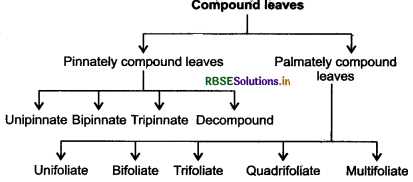
Question 7.
What is pulvinus? What is its function?
Answer:
Swollen leaf base is called pulvinus. It helps to perform seismonastic movements in Mimosapudica.
Question 8.
What term is given to the arrangement of leaves on the stem?
Answer:
Phyllotaxy.
Question 9.
What is bulbil?
Answer:
It is a modification of whole bud into swollen structure due to storage of food materials.
Question 10.
Name an insectivorous angiospermic plant without roots.
Answer:
Utricularia.
Question 11.
Name a free floating aquatic plant with photosynthetic roots.
Answer:
Trapa.
Question 12.
Name two plants that produce rhizomes.
Answer:
Ginger and turmeric.
Question 13.
What is heterophylly?
Answer:
It is a condition of plant in which the foliage leaves are of more than one type. e. g., Limnophila heterophylla.
Question 14.
Define venation.
Answer:
An arrangement of vein and veinlets in the leaf lamina is called venation.
Question 15.
Define phyllotaxy.
Answer:
The mode of arrangement of leaves on the stem and its branches is called phyllotaxy.
Quesiton 16.
Name a plant having bipinnately compound leaves.
Answer:
Acacia nilotica.

Quesiton 17.
What is phyllode? Give one example of it.
Answer:
Petiole or rachis modified into leaf like structure is called phylloids. Example: Parkinsonia.
Question 18.
Give the names of plants in which following types of inflorescences are found: Catkin, capitulum and spikelet.
Answer:
Catkin: Mulberry.
Capitulum: Sunflower
Spikelet: Oat.
Question 19.
Name the cultivated plant in which neither fruits nor seeds are formed.
Answer:
Sugar cane.
Question 20.
Give three examples of false fruits.
Answer:
Apple, pineapple, jack fruit.
Short Answer Type Questions - I
Question 1.
Distinguish between alternate and whorled phyllotaxy.
Answer:
In case of alternate phyllotaxy only one leaf is borne at each node. In each of whorled phyllotaxy more than two leaves arise at each node.

Question 2.
Distinguish between root climbers and stem climbers.
Answer:
Boot climbers climb up the support with the help of adventitious roots whereas stem climbers climb up the support with the help of stem thorns or stem tendrils.
Question 3.
Give any two reasons to justify that onion bulb is a modified stem.
Answer:
- It bears a large number of fibrous roots at its base.
- It bears several fleshy sheathing leaf bases and a terminal bud.
Question 4.
What are false fruits? Give two examples.
Answer:
The fruits develop from parts other than ripened ovary are called false fruits, e.g., fruits of apple and pear which develop from the fleshy thalamus.
Question 5.
Mention two types of venation with examples.
Answer:
Raticulate venation (Ficus rejigeosa) and parallel venation (Banana).
Question 6.
Mention the function of
(i) Underground stem of ginger
(ii) Axillary bud in citrus.
Answer:
(i) Storage of food and vegetative reproduction.
(ii) It grows into thorn and provides protection against grazing by animal.

Question 7.
Mention the functions performed by:
(i) Scale leaf of onion
(ii) Axillary bud of cucumber
(iii) Tap root of beet.
Answer:
(i) It provides protection and coverage.
(ii) It gets modified into tendril and provides support.
(iii) It stores food material.
Question 8.
Write the floral formula of solanaceae.
Answer:

Question 9.
What is imbricate aestivation?
Answer:
Out of five sepals or petals, one external, one internal and other three are partly external, and partly internal.
Question 10.
Write the botanical names of following:
(a) Tomato
(b) Chillies and
(c) Tobacco.
Answer:
(a) Lycopersicon lycopersicum
(b) Capsium annuurn
(c) Nicotina tobacum
Short Answer Type Questions - II
Question 1.
Distinguish between tap root and adventitious root.
Answer:
|
Tap Root |
Adventitious Root |
|
1. It originates from the radicle of embryo. |
1. It does not arise from radicle but from any other part of the plant. |
|
2. Primary root is never destroyed. |
2. Primary root is short lived (ephemeral). |
|
3. It is always underground. |
3. It may be aerial or underground. |
|
4. Main root is only one. |
4. To many roots arise in bunch. |
|
5. Generally it goes deep into the soil. |
5. It does not grow deep into the soil. |
|
6. Main root is thicker than rest of the root. |
6. All the roots are fibrous. |
|
7. Primary, secondary and tertiary roots are present. |
7. No such differentiation is found here. |
|
8. It is present in dicotyledons plants. |
8. It is present in monocotyledon plants. |

Question 2.
Describe the different regions of root with diagram.
Answer:
The root is covered at the apex by a thimble-like structure called the root cap (Fig. 5.4). It protects the tender apex of the root as it makes its way through the soil. A few millimeters above the root cap is the region of meristematic activity. The cells of this regions are very small, thin-walled and with dense protoplasm. They divide repeatedly. The cells proximal to this region undergo rapid elongation and enlargement and are responsible for the growth of the root length.
This region is called the region of elongation. The cells of the elongation zone gradually differentiate and mature. Hence, this zone, proximal to the region of elongation, is called the region of maturation. From this region some of the epidermal cells form very fine and delicate, thread like structures called root hairs. These root hairs absorb water and mineral from the soil.
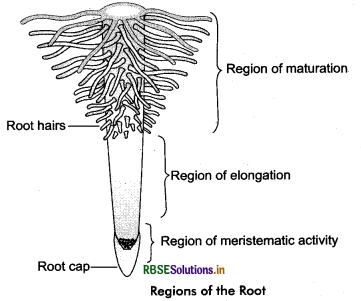
Question 3.
Differentiate between stem and root.
Answer:
|
Stem |
Root |
|
1. Stem develops from plumule of embryo. |
1. Root develops from radicle of embryo. |
|
2. Nodes and internodes are present in stems. |
2. Nodes and internodes are not present in roots. |
|
3. Colour of immature stem is green. |
3. Due to absence of chlorophyll, the color of roots are not green. |
|
4. Buds, leaves, flower and fruits are present on stem. |
4. All these structures are absent on root. |
|
5. Stem always grows above the soil towards sunlight. |
5. Root always grow towards gravity opposite to sunlight. |
|
6. Multicellular hairs are present on stem for protection. |
6. Generally unicellular hairs are present on root which absorbs water and mineral from soil. |
|
7. No cap like structure is present on apical bud for protection. |
7. The meristernatic region of apical part is protected with root cap. |
Question 4.
Distinguish between simple and compound leaves.
Answer:
|
Simple Leaf |
Compound Leaf |
|
1. Only one leaflet is present in simple leaf having spreading veins. |
1. Leaf margin is divided into two or more than two leaflets. |
|
2. Stipules may be present at leaf base. |
2. Stipules are not present at leaflet base but at the leaf base. |
|
3. Bud is present at the axis of leaf. Example: Peepal, Banyan, Hibiscus, Brinjal. |
3. Bud is not present at the axis of leaflet base but present at the axis of leaf. Example: Lemon, Rose, Babool, Coriander. |
Question 5.
Describe phyllotaxy with examples.
Answer:
Phyllotaxy is the pattern of arrangement of leaves on the stem or branch. This is usually of three types : alternate, opposite and whorled. (Fig. 5.12). In alternate type of phyllotaxy, a single leaf arises at each node in alternate manner, as in china rose, mustard and sunflower plants. In opposite type, a pair of leaves arise at each node and lie opposite to each other as in Calotropis and guava plants. If more than two leaves arise at a node and form a whorl, it is called whorled. as in Alstonia.


Question 6.
Describe the modifications of leaves.
Answer:
Leaves are often modified to perform functions other than photosynthesis. They are converted into tendrils for climbing as in peas or into spines for defence as in cacti. (Fig. 5.13 a, b). The fleshy leaves of onion and garlic store food (fig. 5.13 c). In some plants such as Australian acacia, the leaves are small and short - lived. The petioles in these plants expand, become green and synthesize food. Leaves of certain insectivorous plants such as pitcher plant, venus - fly trap are also modified leaves.
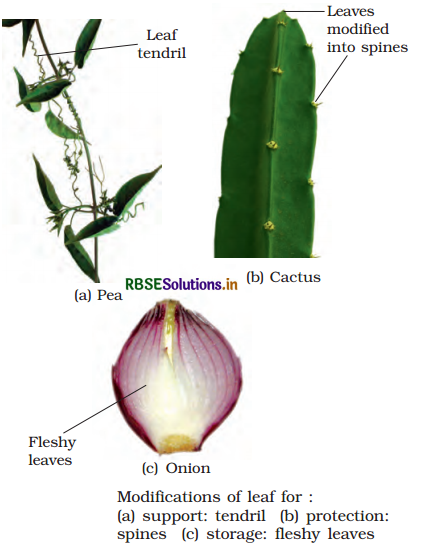
Question 7.
Differentiate between racemose and cymose inflorescence.
Answer:
|
Racemose Inflorescence |
Cymose Inflorescence |
|
1. Growth of main axis is indefinite. |
1. Growth of main axis is definite due to formation of flower on the apical part. |
|
2. Older flower are present at the basal side of the main axis whereas new buds are formed at the apical side. |
2. Older flower are present at the apical side of the main axis whereas new buds are formed at the basal side. |
|
3. Arrangement of flowers is in acropetal manner. |
3. Arrangement of flowers is in basipetal manner. |
|
4. Number of flowers is indefinite. |
4. Number of flowers is definite. |
Question 8.
Define aestivation. Give its different types.
Answer:
Aestivation: The mode of arrangement of sepals or petals in floral bud with respect to the other members of the same whorl is known as aestivation. The main types of aestivation are valvate, twisted, imbricate and vexillary (Fig. 5.18). When sepals or petals in a whorl just touch one another at the margin, without overlapping , as in Calotropis, it is said to be valvate. If one margin of the appendage overlaps that of the next one and so on as in china rose, lady's finger and cotton, it is called twisted. If the margins of sepals or petals overlap one another but not in any particular direction as in Cassia and gulmohur, the aestivation is called imbricate. In pea and bean flowers, there are five petals, the largest (standard) overlaps the two lateral petals (wings) which in turn overlap the two smallest anterior petals (keel); this type of aestivation is known as vexillary or papilionaceous.
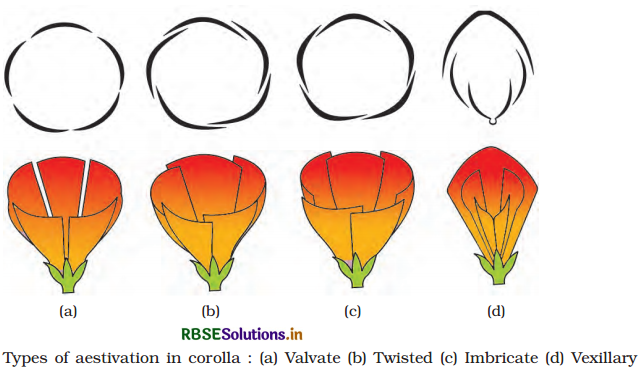
Question 9.
Describe simple fruits and their types with examples.
Answer:
1. Simple fruits: These fruits develops from unicarpellary or multicarpellary syncarpous ovary. They are of two types:
(A) Dry fruits
(B) Succulent fruits
A. Dry fruits: The pericarp is dry, hard, chafy, woody or membranous. These fruits are of three types:
(i) Dehiscent fruit
(ii) Indehiscent fruit
(iii) Schizocarpic fruit
(i) Dehiscent fruit: These fruits rupture after ripening. They are of following types:
(a) Legume or pod: They develop from monocarpellary syncarpous ovary. Mature fruits on ripening dehisce from two sutures (line of dehiscence). Like: pea, beans etc.
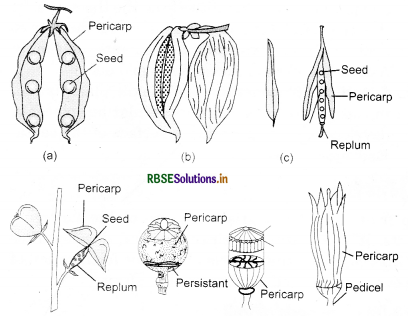
(b) Follicle: In this type, dehiscence occurs from only one suture. Rest of the characters is like that of legume. Like: milkweed, plumeria (champa).
(c) Siliqua: This fruit develops from bicarpellary, syncarpous superior.ovary. Initially, the ovary is unicarpellary, but it becomes bicarpellary due to formation of false replum. Like: Mustard.
(d) Silicula: It is totally like siliqua, except its length and breadth are equal. Like: Capsella.
(e) Capsule: These fruits develops from multicarpellary, syncarpous, superior or inferior ovary. They dehisce by various methods. Like: cotton, lady's finger, nigella etc.
(ii) indehiscent or Achenlal fruit: These fruits do not dehisce on ripening. Their seeds shed at the rottening of fruit. They are of following types:
(a) Achene: These fruits develop from unicarpellary, superior ovary. The pericarp is separated from the sead coat. Like: Climatis, Ranunculus etc.
(b) Caryopsis: It develops from unicarpellary, superior ovary. The pericarp is fused with the sead coat. Like: Wheat, Maize etc.
(c) Cypsella: It develops from bicarpellary, syncarpous and inferior ovary. Hairy pappus is found attached to it. Like: Sunflower and Marigold.
(d) Nut: These fruits are unilocular and single seeded and develop from bi or multicarpellary, syncarpous, superior ovary. Like: Cashewnut, Litchi, Trapa.
(e) Samara: These fruits are single seeded. They have flattened winged pericarp. Like: Holoptelea (Chilbil).
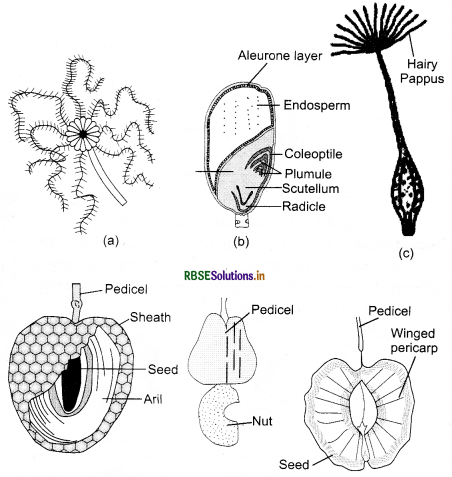
(iii) Schizocarpic fruit: They are multi seeded and break into small mericarp at maturity. They are of following types:
(a) Lomentum: These fruits develop from unicarpellary, superior ovary. Pericarp constricts to divide fruit into single seeded mericarps. Like: Tamarind, Babool etc.
(b) Cremocarp: These fruits are bilocular and two seeded. They develop from bicarpellary and inferior ovary. The fruit, at maturity splits from bottom towards upward into two single seeded mericarps which are attached through carpophores. Like: Coriander, Cumin etc.
(c) Carcerulus: This type of fruit develops from bicarpellary, syncarpous superior ovary. Each ovary is divided into a single mericarp. Like: Tulsi, Salvia etc.
(d) Regma: This fruit develops from multicarpellary ovary and on maturity gets divided into single seeded units called cocci. Like: Castor
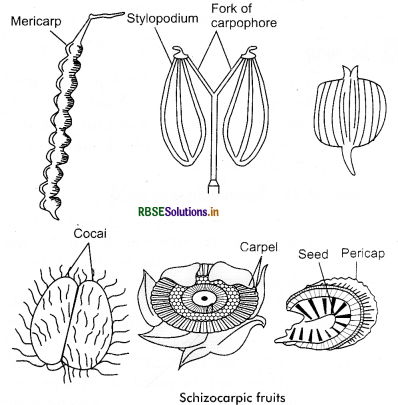
B. Succulent fruits: These fruits are indehiscent and have fleshy pericarp. The pericarp is divided into three parts - Epicarp, Mesocarp and Endocarp. They are of following types:
(i) Drupe: These fruit develops from unicarpellary or multicarpellary, syncarpous, superior ovary. The epicarp is thin and forms the peel, mesocarp is fleshy or fibrous and endocarp is woody and hard. Like: Mango, coconut.
(ii) Berry: These fruit develops from unicarpellary or multicarpellary, syncarpous ovary. Whole pericarp is fleshy. Seeds are embedded in mesocarp. Endocarp is membranous or fleshy. Like: Tomato, Banana, and Guava etc.
(iii) Pepo: These fruits are very much similar to berry. But they are derived from inferior ovary of parietal placentation. Its epicarp is hard and chafy called rind. In simple words, berry with rind is called as pepo. Like: Cucumber, Watermelon, Muskmelon etc.
(iv) Pome: It is a false fruit. Edible part of fruit is fleshy thalamus. It is formed due to spreading of thalamus around syncarpous, inferior ovary. Like: Apple, Pear etc.
(v) Hesperidium: These fruits develop from multicarpellary, superior ovary. Epicarp is chafy and contains oil glands, mesocarp is thin and fibrous and endocarp is thin membranous bearing edible glandular hairs. Like: Orange. Lemon.
(vi) Balausta: Pericarp of the fruit is hard. Seeds are randomly arranged on placenta. Endocarp is hard and chafy. Edible part is juicy seed coat. Like: Pomegranate.
(vii) Amphisarca: Epicarp is woody. Mesocarp, endocarp and placenta is fleshy which is edible. Like: Wood apple etc.
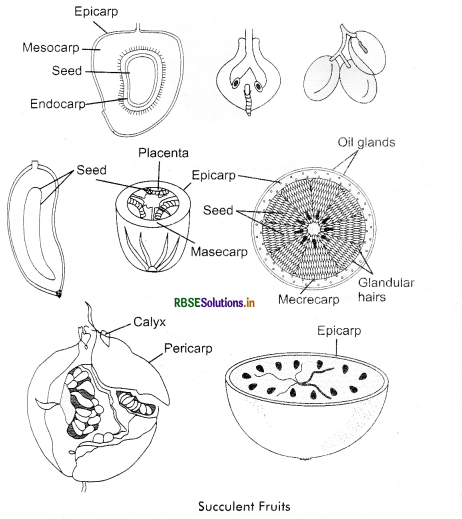
Question 10.
Write short notes on:
(i) Schizocarpic fruits
(ii) Composite or multiple fruits.
Answer:
(i) Schizocarpic fruit: They are multi seeded and break into small mericarp at maturity. They are of following types:
(a) Lomentum: These fruits develop from unicarpellary, superior ovary. Pericarp constricts to divide fruit into single seeded mericarps. Like: Tamarind, Babool etc.
(b) Cremocarp: These fruits are bilocular and two seeded. They develop from bicarpellary and inferior ovary. The fruit, at maturity splits from bottom towards upward into two single seeded mericarps which are attached through carpophores. Like: Coriander, Cumin etc.
(c) Carcerulus: This type of fruit develops from bicarpellary, syncarpous superior ovary. Each ovary is divided into a single mericarp. Like: Tulsi, Salvia etc.
(d) Regma: This fruit develops from multicarpellary ovary and on maturity gets divided into single seeded
units called cocci. Like: Castor
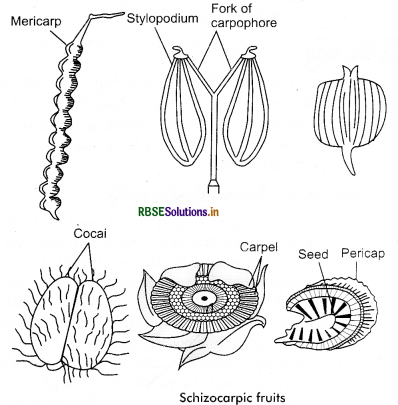
(ii) Composite or Multiple fruits: Composite fruits are formed from whole inflorescence. Several parts of inflorescence like bracts, peduncle and tepals etc., get converted into parts of fruits. They are called false fruits. They are mainly of two types:
A. Sorosis: These fruits develop from catkin, spadix, spike etc. types of inflorescence. Like in Mulberry, the real fruit is achene but all parts of inflorescence represent the fruits. In jackfruit and pineapple few parts of flower form the rind, whereas other parts become fleshy and juicy to form pulp.
B. Syeonus: These fruits develop from hypanthodium inflorescence. Peduncle or mother stem of inflorescence forms cup shaped fleshy receptacle which is edible. Several flowers inside receptacle form separate small achenes.
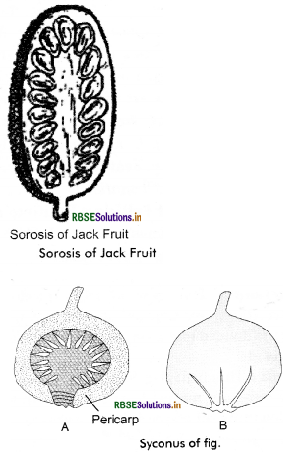

Question 11.
Describe in brief the various types of placentation found in flowering plants.
Answer:
Placentation: The arrangement of ovules within the ovary is known as placentation. The placentation are of different types namely, marginal, axile, parietal, basal, central and free central (Fig. 5.22).

1. Marginal placentation: In marginal placentation, the ovary is monocarpellary, unilocular and the placenta develops from the joining of both the margins of carpels, as in members of pea family.
2. Axile placentation: In axile placentation, the ovary is multilocular and the number of carpels is more than one. Numbers of locules in ovary is almost equal to the number of carpels. Ovules join at the central axis of the ovary. Example: Datura, Hibiscus.
3. Parietal placentation: In parietal placentation, the ovary is multicarpellary and unilocular. The ovules develop on the inner wall of the ovary or on peripheral part. Example: mustard, radish, papaya etc.
4. Free central placentation: When the septa are absent in multilocular ovary, the ovules borne on the central axis then it is called free central placentation. Example: Stellaria, Primrose etc.
5. Basal placentation: In this the ovary is unilocular and placenta develops directly on the thalamus. In this type of placentation, normally the number of ovule is one. Example: in plants of family Asteraceae like sunflower, marigold etc.
6. Superficial placentation: Like axile placentation, in this also the ovary is multilocular but placenta develops on the entire inner surface of the septa. Example: water lily.

Question 12.
Describe the corolla of family - Fabaceae.
Answer:
Corolla of the family - Fabaceae is papilionaceous i.e., consisting of a posterior standard or vexillum, two lateral wings or alae and the anterior petals fused along margin to form keel or carina.
Long Answer Type Questions
Question 1.
Describe the various rolls of roots and stem of an angiospermic plant.
Answer:
Funcitons of Root:
A. Primary or General Functions:
- Fixation: Root fixes the plant in soil and supports the shoot.
- Absorption: Root hairs present on the root helps in absorption of water and dissolved minerals from the soil.
- Conduction: Transportation of water absorbed by the root hairs is performed by the xylem tissue of stem and root.
B. Secondary or Accessory Functions: Apart from performing general functions, some roots also perform special functions for which different modifications are present in them. Some examples are:
- Food storage: Example: carrot, radish, turnip, sweat potato etc.
- Climbing: In money plant etc., roots are helpful in climbing.
- Extra support: Prop root and stilt root perform functions of extra support.
- Nitrogen Fixation: Nitrogen fixing bacteria are present in root of some leguminous plants which fixes atmospheric nitrogen.
- Respiration: Example: Bruguiera, Rhizophora.
- Moisture absorption: Epiphytic roots of Orchids.
- Parasite roots: For the absorption of food e.g. Cuscuta.
- Food synthesis: Green roots of Tinospora, Trapa etc., prepares food through photosynthesis.
- Floating: Roots of some aquatic plants store air and helps in floating E.g. Lotus.
- Reproduction: Adventitious buds in some plants helps in reproduction. Example: Begonia, Bryophyllum, sweat potato.
Functions of Stem:
A. Primary or General Functions:
- Conduction: It transports water and dissolved minerals from roots to leaves, fruits and flowers.
- It transports food prepared by leaves to roots, fruits and other storage organs.
- Stem bears branches, leaves, fruits and flowers. Leaves are arranged on stem in such a manner so that each leaf gets proper sunlight.
- It keeps on forming new cells, tissues and organs for continuous functioning of plants.
B. Secondary or Special Functions: Apart from performing general functions, stems also perform special functions for which different modifications are present in them. Some examples are:
- It works for perennation in plants i.e., it works to protect plants in unfavourable conditions; E.g., Fern, ginger, turmeric etc.
- Stem functions as food storage organs in many plants. E.g., potato, Colocasia, ginger, zaminkand etc.
- In many plants stem functions as food and water storage organ. E.g., Opuntia, Cactus etc.
- Modification of stem tendrils help in climbing. Stem also helps in vegetative reproduction in many plants. E.g., grass, strawberry, Eichornia, potato etc.
- Stem is modified into thorn in xerophytic plants which reduces transpiration and protects the plants.
- Modification into phylloclade and cladode perform photosynthesis.
- Flower is modified stem. It helps in reproduction.
Question 2.
What are underground stems? Describe various forms of underground stem. Draw diagram and given one example of each form.
Answer:
The stems get modified to perform various functions and lack green colour due to its geophilous nature and grow under the ground and identified by the presence of nodes, internodes, scale leaves, buds and branches. These are of various types:
Sucker: The - sub aerial branch that arises from the main stem and it grows initially grows horizontally below soil later grows obliquely upward. Examples are Mentha arvensis.
Stem tuber: The tuberous tip of an underground branch. The axillary branches that are produced near the soil surface grow into the soil and their tip becomes swollen due to the accumulation of starch. The example is Solanum tuberosum.
Rhizome: Its is a thick, underground dorsiventral stem that grows horizontally at a particular depth within the soil. The example is Ginger.
Corm: It is the underground modification of the main stem with more diameter than length. It stores food materials and become tuberous. The example is Colocasia.
Bulb: A specialized underground stem which bears roots in its lowers sides and rosette of leaves on the upper side. The leaf bases or scales become fleshy due to the accumulation of food. The example is Allium cepa.
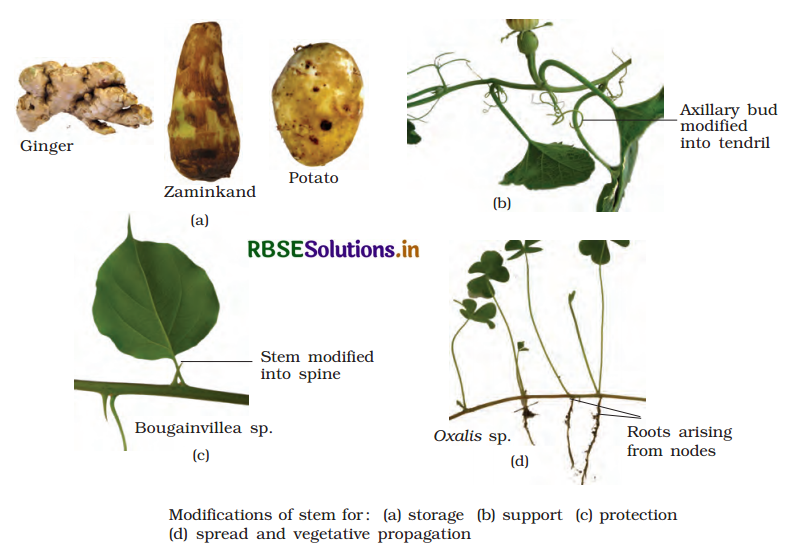

Question 3.
What are succulent fruits? Describe their various types with suitable examples.
Answer:
Succulent fruits: These fruits are indehiscent and have fleshy pericarp. The pericarp is divided into three parts - Epicarp, Mesocarp and Endocarp. They are of following types:
- Drupe: These fruit develops from unicarpellary or multicarpellary, syncarpous, superior ovary. The epicarp is thin and forms the peel, mesocarp is fleshy or fibrous and endocarp is woody and hard. Like: Mango, coconut.
- Berry: These fruit develops from unicarpellary or multicarpellary, syncarpous ovary. Whole pericarp is fleshy. Seeds are embedded in mesocarp. Endocarp is membranous or fleshy. Like: Tomato, Banana, and Guava etc.
- Pepo: These fruits are very much similar to berry. But they are derived from inferior ovary of parietal placentation. Its epicarp is hard and chafy called rind. In simple words, berry with rind is called as pepo. Like: Cucumber, Watermelon, Muskmelon etc.
- Pome: It is a false fruit. Edible part of fruit is fleshy thalamus. It is formed due to spreading of thalamus around syncarpous, inferior ovary. Like: Apple, Pear etc.
- Hesperidium: These fruits develop from multicarpellary, superior ovary. Epicarp is chafy and contains oil glands, mesocarp is thin and fibrous and endocarp is thin membranous bearing edible glandular hairs. Like: Orange. Lemon.
- Balausta: Pericarp of the fruit is hard. Seeds are randomly arranged on placenta. Endocarp is hard and chafy. Edible part is juicy seed coat. Like: Pomegranate.
- Amphisarca: Epicarp is woody. Mesocarp, endocarp and placenta is fleshy which is edible. Like: Wood apple etc.
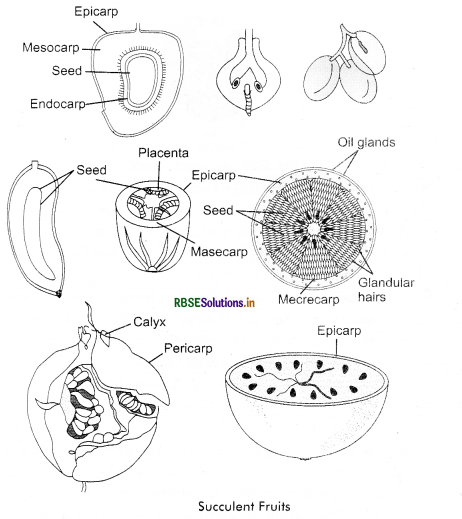
Question 4.
Give a scientific description of family liliaceae. Mention the economic importance.
Answer:
Commonly called the ‘Lily family’ is a characteristic representative of monocotyledonous plants. It is distributed world wide (Fig. 5.37)
Vegetative Characters:
Habit: Perennial herbs, some plants hedge like e.g., Ruscus, climber e.g., Smilax or small trees e.g., Yucca.
Stem: aerial, erect or climber, branched, flowering branch in form of Scape; Sometimes modified such as cladode e.g., Ruscus, Asparagus; bulb e.g., Onion (Allium cepa)
Leaves: radical or cauline, exstipulate, simple, parallel venation. Stipulates are modified into tendrils e.g., Smilax.
Floral Characters
Inflorescence: solitary/cymose; often umbellate clusters
Flower: bisexual, actinomorphic, bracteate, pedicellate, complete, hermaphrodite, hypogynous, trimerous.
Perianth: tepals six, 3 + 3, often united into tube, valvate aestivation.
Androecium: stamen six, 3 + 3, epipetalous.
Gynoecium: tricarpellary, syncarpous, ovary superior, trilocular with many ovules; axile placentation.
Fruit: capsule, rarely berry
Seed: endospermous
Floral Formula: 
Economic Importance
- Food: Onion and garlic
- Medicine: Aloe
- Ornamental plants: Lily, Yucca (Dragon plant), Tulip, Gloriosa
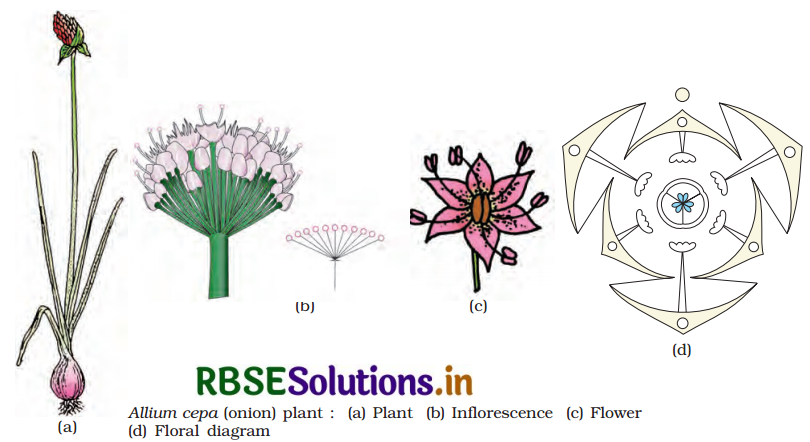
Question 5.
Give an account of the distinguishing features of family solanaceae. Give botanical names of four plants of economic value belonging to this family.
Answer:
It is a large family, commonly called as the ‘potato family’. It is widely distributed in tropics, subtropics and even temperate zones (Fig. 5.36)
Vegetative Characters:
Habit: Plants mostly herbs, shrubs and rarely small trees
Stem: herbaceous, rarely woody, aerial; erect, cylindrical, branched, solid or hollow, hairy or glabrous, underground stem in potato (Solarium tuberosum)
Leaves: alternate, simple, rarely pinnately compound, exstipulate; venation reticulate
Floral Characters
Inflorescence: solitary, axillary or cymose as in Solarium.
Flower: bisexual, actinomorphic
Calyx: sepals five, united, persistent, valvate aestivation
Corolla: petals five, united; valvate aestivation.
Androecium: stamens five, epipetalous
Gynoecium: bicarpellary obligately placed, syncarpous; ovary superior, bilocular, placenta swollen with many ovules, axile.
Fruit: berry or capsule.
Seeds: many, endospermous
Floral Formula : 
Economic Importance
- Food: tomato, brinjal, potato, etc are eaten as vegetables and salad, raspberry eaten as fruit and chilli used as spices.
- Industry: leaves of tobacco are used in tobacco industry for making bidi, ciggrette etc.
- Medicine: Different types of medicines are obtained from Atropa belladonna, Bignonia, Nicotiana etc.
- 4. Ornamental plants: petunia, henbane, night queen are grown in garden as ornamental plants.
